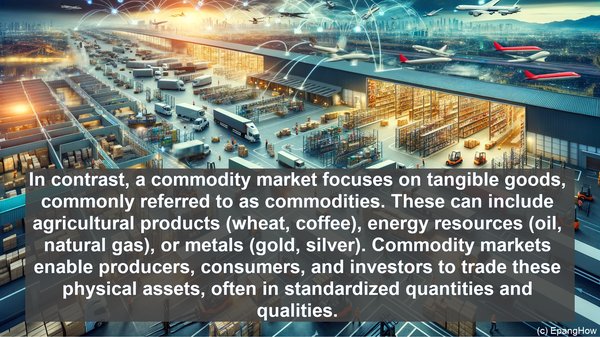Introduction: The Vast Landscape of Markets
Globally, numerous markets facilitate the exchange of goods, services, and financial instruments. Two prominent types are financial markets and commodity markets. While they share some similarities, they differ significantly in their underlying assets, trading mechanisms, and purposes.

Financial Market: The Realm of Capital
A financial market primarily deals with financial instruments, such as stocks, bonds, currencies, and derivatives. It serves as a platform for individuals, institutions, and governments to raise capital, invest, and manage risks. The transactions in financial markets often involve the transfer of ownership or the creation of new financial assets.
Commodity Market: The World of Tangible Goods
In contrast, a commodity market focuses on tangible goods, commonly referred to as commodities. These can include agricultural products (wheat, coffee), energy resources (oil, natural gas), or metals (gold, silver). Commodity markets enable producers, consumers, and investors to trade these physical assets, often in standardized quantities and qualities.

Trading Dynamics: Spot, Futures, and Options
Both financial and commodity markets offer various trading mechanisms. In financial markets, spot trading involves the immediate exchange of assets at the current market price. Additionally, futures and options contracts allow parties to agree on buying or selling assets at predetermined prices in the future. Commodity markets, too, employ these mechanisms, but with a focus on the physical delivery of the underlying goods.
Price Determination: Factors at Play
Price discovery in financial markets is often driven by factors such as supply and demand, economic indicators, and investor sentiment. In commodity markets, besides these factors, the forces of nature, geopolitical events, and storage capacities can significantly impact prices. For instance, a drought in a major agricultural region can lead to a surge in grain prices.
Risk Management: Hedging and Speculation
Both markets offer tools for risk management. Hedging, a common strategy, involves taking offsetting positions to mitigate potential losses. In financial markets, this can be achieved through derivatives like options or futures. Commodity markets, on the other hand, allow producers and consumers to hedge against price fluctuations by locking in future prices through futures contracts. Speculation, though, involves taking positions to profit from anticipated price movements and is more common in financial markets.
Market Impact: Global and Local
Financial markets, especially those dealing with currencies and stocks, have a profound impact on the global economy. News of a major merger or a central bank’s decision can send ripples across markets worldwide. Commodity markets, while also global in nature, often have more localized impacts. For instance, a surge in oil prices can affect transportation costs, inflation, and economic growth in various countries.
